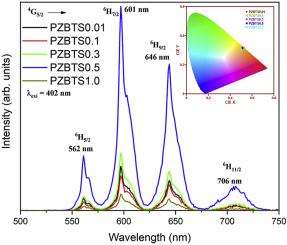Our official English website, www.x-mol.net, welcomes your
feedback! (Note: you will need to create a separate account there.)
Reddish-orange emission and Judd-Ofelt investigation of Sm3+ ions doped in zince-bismuth-phospho-tellurite glasses for solid lighting application
Journal of Luminescence ( IF 3.3 ) Pub Date : 2020-10-01 , DOI: 10.1016/j.jlumin.2020.117498 Sangeeta B. Kolavekar , N.H. Ayachit , R. Rajaramakrishna , Pramod N G , J. Kaewkhao
Journal of Luminescence ( IF 3.3 ) Pub Date : 2020-10-01 , DOI: 10.1016/j.jlumin.2020.117498 Sangeeta B. Kolavekar , N.H. Ayachit , R. Rajaramakrishna , Pramod N G , J. Kaewkhao

|
Abstract In this paper, physical, structural and optical properties of zinc bismuth phospho tellurite glass doped with various concentration of Sm3+ ions (x = 0.01, 0.1, 0.3, 0.5 and 1 mol%) were prepared by melt quenching technique. With keen interest in luminescence properties of samarium, spectroscopic properties are investigated using optical absorption spectra, excitation spectra, emission spectra and decay profiles. Applying Judd-Ofelt theoretical approach an effort is made to understand the asymmetry of samarium in phosphate host glass matrix. Using this theory three important parameters such as Ω2, Ω4, Ω6 are determined to calculate emission properties for certain Sm3+ transitions. Luminescence parameters such as stimulated emission cross section (σp) and branching ratios (βexp) have been studied through photoluminescence spectra. The PL spectra for all glasses show four emission bands centered between 561, 601, 646 and 708 owing to the 4G5/2 → 6H5/2 (561), 6H7/2 (601), 6H9/2(646) and 6H11/2(708) transitions of Sm3+ doped PZBTS glass system. Decay time data reveals that single exponential behavior of Sm3+ ions up to 0.5mol%, while non-exponential decay profile for 1 mol% Sm3+ content. CIE1931 chromaticity diagram for the PZBTS glasses were evaluated. CCT values were obtained and shows around 2510 K–2560 K for the prepared glasses. From the results we say that these materials prove to be very good materials for reddish orange lighting applications.
中文翻译:

用于固体照明的锌-铋-磷-碲酸盐玻璃中掺杂的 Sm3+ 离子的红橙色发射和 Judd-Ofelt 研究
摘要 本文采用熔体淬火技术制备了掺杂不同浓度Sm3+离子(x = 0.01、0.1、0.3、0.5和1 mol%)的锌铋磷亚碲酸盐玻璃的物理、结构和光学性能。由于对钐的发光特性有着浓厚的兴趣,因此使用光吸收光谱、激发光谱、发射光谱和衰减曲线研究了光谱特性。应用 Judd-Ofelt 理论方法,努力理解磷酸盐基质玻璃基质中钐的不对称性。使用该理论,确定了三个重要参数,例如 Ω2、Ω4、Ω6,以计算某些 Sm3+ 跃迁的发射特性。已经通过光致发光光谱研究了诸如受激发射截面 (σp) 和分支比 (βexp) 等发光参数。由于 4G5/2 → 6H5/2 (561)、6H7/2 (601)、6H9/2(646) 和 6H11/2,所有玻璃的 PL 光谱显示四个发射带集中在 561、601、646 和 708 之间Sm3+ 掺杂的 PZBTS 玻璃系统的 (708) 跃迁。衰减时间数据显示 Sm3+ 离子的单指数行为高达 0.5 mol%,而 1 mol% Sm3+ 含量的非指数衰减曲线。评估了 PZBTS 眼镜的 CIE1931 色度图。获得的 CCT 值显示制备的玻璃在 2510 K-2560 K 左右。从结果我们可以说这些材料被证明是非常适合红橙色照明应用的材料。衰减时间数据显示 Sm3+ 离子的单指数行为高达 0.5 mol%,而 1 mol% Sm3+ 含量的非指数衰减曲线。评估了 PZBTS 眼镜的 CIE1931 色度图。获得的 CCT 值显示制备的玻璃在 2510 K-2560 K 左右。从结果我们可以说这些材料被证明是非常适合红橙色照明应用的材料。衰减时间数据显示 Sm3+ 离子的单指数行为高达 0.5 mol%,而 1 mol% Sm3+ 含量的非指数衰减曲线。评估了 PZBTS 眼镜的 CIE1931 色度图。获得的 CCT 值显示制备的玻璃在 2510 K-2560 K 左右。从结果我们可以说这些材料被证明是非常适合红橙色照明应用的材料。
更新日期:2020-10-01
中文翻译:

用于固体照明的锌-铋-磷-碲酸盐玻璃中掺杂的 Sm3+ 离子的红橙色发射和 Judd-Ofelt 研究
摘要 本文采用熔体淬火技术制备了掺杂不同浓度Sm3+离子(x = 0.01、0.1、0.3、0.5和1 mol%)的锌铋磷亚碲酸盐玻璃的物理、结构和光学性能。由于对钐的发光特性有着浓厚的兴趣,因此使用光吸收光谱、激发光谱、发射光谱和衰减曲线研究了光谱特性。应用 Judd-Ofelt 理论方法,努力理解磷酸盐基质玻璃基质中钐的不对称性。使用该理论,确定了三个重要参数,例如 Ω2、Ω4、Ω6,以计算某些 Sm3+ 跃迁的发射特性。已经通过光致发光光谱研究了诸如受激发射截面 (σp) 和分支比 (βexp) 等发光参数。由于 4G5/2 → 6H5/2 (561)、6H7/2 (601)、6H9/2(646) 和 6H11/2,所有玻璃的 PL 光谱显示四个发射带集中在 561、601、646 和 708 之间Sm3+ 掺杂的 PZBTS 玻璃系统的 (708) 跃迁。衰减时间数据显示 Sm3+ 离子的单指数行为高达 0.5 mol%,而 1 mol% Sm3+ 含量的非指数衰减曲线。评估了 PZBTS 眼镜的 CIE1931 色度图。获得的 CCT 值显示制备的玻璃在 2510 K-2560 K 左右。从结果我们可以说这些材料被证明是非常适合红橙色照明应用的材料。衰减时间数据显示 Sm3+ 离子的单指数行为高达 0.5 mol%,而 1 mol% Sm3+ 含量的非指数衰减曲线。评估了 PZBTS 眼镜的 CIE1931 色度图。获得的 CCT 值显示制备的玻璃在 2510 K-2560 K 左右。从结果我们可以说这些材料被证明是非常适合红橙色照明应用的材料。衰减时间数据显示 Sm3+ 离子的单指数行为高达 0.5 mol%,而 1 mol% Sm3+ 含量的非指数衰减曲线。评估了 PZBTS 眼镜的 CIE1931 色度图。获得的 CCT 值显示制备的玻璃在 2510 K-2560 K 左右。从结果我们可以说这些材料被证明是非常适合红橙色照明应用的材料。











































 京公网安备 11010802027423号
京公网安备 11010802027423号